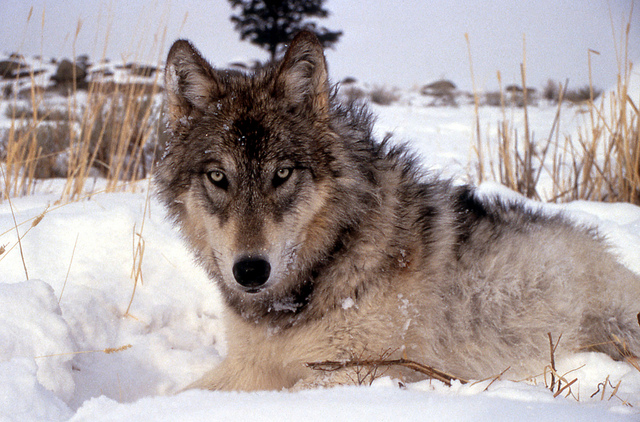But activists say the numbers are not nearly enough to ensure full recovery. "They're utterly deficient," says Amaroq Weiss of the Center for Biological Diversity, one of the groups behind Friday's rally.
"We need to restore the gray wolf to the numbers where it's fulfilling its ecological role," Weiss adds. She points out what happened at Yellowstone National Park, when the gray wolf population was decimated in the 1920s. This resulted in elk — wolves' prey — proliferating and overgrazing on the area flora and fauna, which had a detrimental effect on the larger animal and plant environment. (The gray wolf was reintroduced to Yellowstone in 1995.)
FWS says the gray wolf population is "robust" in eight states – Michigan, Minnesota, Wisconsin, Idaho, Montana, Wyoming, Washington and Oregon. If it does delist the animal, wolf recovery efforts will be left almost entirely to the states.
Which brings us back to OR7. When he crossed into California in December 2011, the Center for Biological Diversity and several other groups petitioned the state to add the gray wolf to its endangered species list. After several years of study, the prospects of state action do not look good, says Weiss. In an op-ed that ran in the Mercury News today she wrote:
The word out of Sacramento this week is that a preliminary state study undergoing peer review tries to make a case against protecting wolves. In fact, OR-7's historic 500-mile journey from Oregon to California makes a very strong case for why wolves need protecting here, offering on-the-ground proof of what top researchers have said for decades: Recovering populations will return to California's thousands of acres of prime, upland wolf habitat.
The question is, will California be prepared to manage them when they get here?
The California Fish and Game Commission is expected to decide in February whether wolves should be protected under the state’s Endangered Species Act. They’ll be using the preliminary state study that Weiss mentioned in her op-ed. According to a report from Capital Press, the study recommends against endangered species protections because currently, there aren’t any wolves in the state.
Should a wolf wander into California without being protected as a state or federal endangered species, it would be considered a “non-game” mammal, which means it can’t be hunted, but could be killed for causing property damage.
California is planning for more wolves. State officials have convened stakeholders including ranching, hunting and environmental groups to put together a statewide wolf management plan. The plan would look at where wolves could expand to in California and will examine how other states have managed conflicts between wolves and livestock.
Hunting wolves is already allowed in the northern Rockies, and about 56 were killed in Wyoming this year, according to the Denver Post. Michigan held its first-ever wolf hunt last Friday -- an effort, say state officials, to reduce wolf depredation.
A public hearing on the U.S. Fish & Wildlife Service proposal to delist the gray wolf from the Endangered Species Act will be held on Friday, Nov. 22, 6-8:30 p.m., the Marriott Courtyard Sacramento Cal Expo, Golden State Ballroom, 1782 Tribute Road, Sacramento. A rally by those opposed to the delisting is scheduled the same day at 4 p.m. at the entrance to the Marriott.
